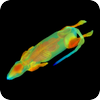
RESEARCH
RAT THERMOREGULATORY MODELING

We aim to develop mathematical models that link heat exposure to organ damage in a rat animal model. To this end, we are developing physiological models based on the three-dimensional anatomy of a rat, in order to quantitatively describe the spatial-temporal temperature distribution across the animal's organs in response to exertional and environmental heat stressors. By integrating this information with the associated dynamic changes in gene products, we aim to develop molecular models that correlate with organ damage.
Publications
Scheff, J. D., J. D. Stallings, J. Reifman, and V. Rakesh. Mathematical modeling of the heat-shock response in HeLa cells. Biophysical Journal. 2015 July 12; 109(2):182-193. [PDF, PubMed]
Ippolito, D. L., J. A. Lewis, C. Yu, L. R. Leon, and J. D. Stallings. Alteration in circulating metabolites during and after heat stress in the conscious rat: potential biomarkers of exposure and organ-specific injury. BMC Physiology. 2014 December 24; 14:14. [PDF, PubMed]
Stallings, J. D., D. L. Ippolito, V. Rakesh, C. E. Baer, W. E. Dennis, B. G. Helwig, D. A. Jackson, L. R. Leon, J. A. Lewis, and J. Reifman. Patterns of gene expression associated with recovery and injury in heat-stressed rats. BMC Genomics. 2014 December 3; 15:1058. [PDF, PubMed]
Rakesh, V., J. D. Stallings, and J. Reifman. A virtual rat for simulating environmental and exertional heat stress. Journal of Applied Physiology. 2014 December 1; 117(11):1278-1286. [PDF, PubMed]
Rakesh, V., J. D. Stallings, B. G. Helwig, L. R. Leon, D. A. Jackson, and J. Reifman. A 3-D mathematical model to identify organ-specific risks in rats during thermal stress. Journal of Applied Physiology. 2013 December 15; 115(12):1822-1837. [PDF, PubMed]